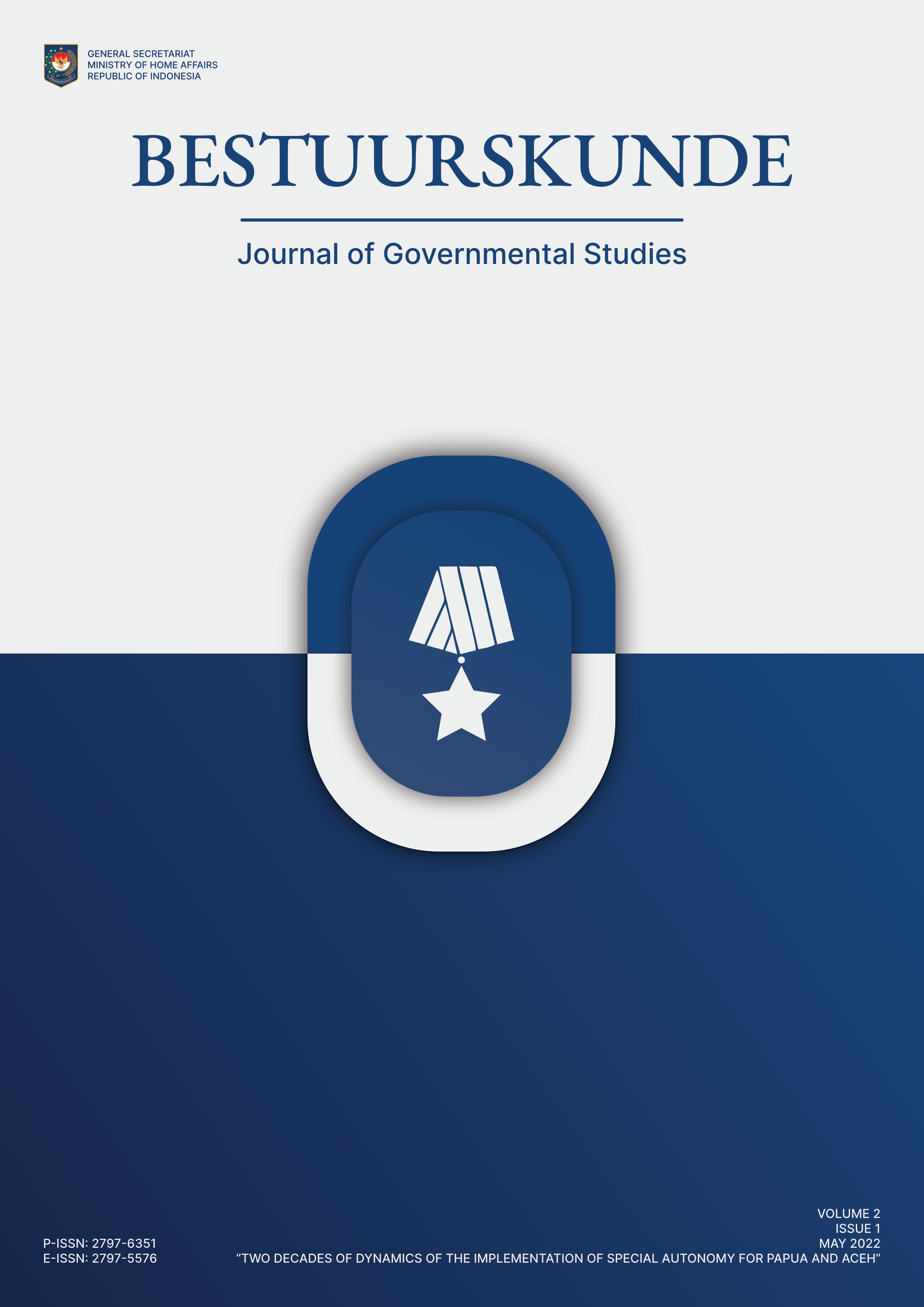Special Autonomy Implementation and Its Impact on the Welfare of the Society: A Short Review

Abstrak
Indonesia has been going through long and difficult times to be an independent country. The struggles to break from colonialism out were in concordance with Indonesia's efforts to maintain and secure its territorial sovereignty. Upheavals, threats, and even separatism often arose in various parts of the country, even since the early days of Indonesia's independence. Aceh is no different. The perceived injustice in the distribution of benefits from natural resources had led to conflict in Aceh in the past. To deal with this issue, through the enactment of the Law No. 11 of 2006, the central government granted the special autonomy status for Aceh to induce peace and security, while achieving social justice within the province. The special autonomy status was also intended to accelerate the economy and improve education, quality of life, health, and infrastructure. The implementation of the special autonomy and how it contributes to the improvement of the welfare of the Aceh residents are critical and interesting to analyze. In this study, the “welfare” was analyzed based on four aspects of analysis: (1) poverty alleviation, (2) unemployment alleviation, (3) Human Development Index (HDI), and (4) Gini Ratio. The study adopted a qualitative exploratory research design, in which data were derived from analysis of secondary sources obtained through literature review. The results of the study showed that Aceh was heavily dependent on the Special Autonomy Fund. The Aceh Provincial Government set seven priority sectors: infrastructure, economic empowerment, poverty alleviation, education, social, health, and Aceh privileges. Furthermore, other than improving the Gini Ratio, the Aceh special autonomy fund has had a positive impact on the welfare of the Acehnese in general.
Kata Kunci
Gini Ratio, Human Development Index, Implementation, Poverty, Special Autonomy, Special Autonomy Fund, Unemployment, Welfare
Referensi
- Badan Pusat Statistik. (2021a). Gini Ratio Provinsi 2002-2020. Badan Pusat Statistik. https://www.bps.go.id/dynamictable/2017/04/26%2000:00:00/1116/gini-ratio-provinsi-2002-2018.html
- Badan Pusat Statistik. (2021b). Indeks Pembangunan Manusia menurut Provinsi. Badan Pusat Statistik. https://www.bps.go.id/indicator/26/494/1/-metode-baru-indeks-pembangunan-manusia-menurut-provinsi.html
- Badan Pusat Statistik. (2021c). Persentase Penduduk Miskin Menurut Provinsi 2007-2020. Badan Pusat Statistik. https://www.bps.go.id/dynamictable/2016/08/18%2000:00:00/1219/persentase-penduduk-miskin-menurut-provinsi-2007---2019.html
- Badan Pusat Statistik. (2021d). Tingkat Pengangguran Terbuka Menurut Provinsi (Persen). Badan Pusat Statistik. https://www.bps.go.id/indicator/6/543/1/tingkat-pengangguran-terbuka-menurut-provinsi.html
- BAKN DPR RI. (2020). Penelaahan Atas Dana Otonomi Khusus Provinsi Aceh. BAKN DPR RI.
- Bandur, A. (2019). Qualitative Research, Multi-Disciplinary Study Scientific with NVivo 12 Plus (Perth Edition). Mitra Discourse Media.
- Cahyono, H. (2012). Evaluasi atas Pelaksanaan Otonomi Khusus Aceh: Gagal Menyejahterakan Rakyat dan Sarat Konflik Internal. Jurnal Penelitian Politik, 9(2). https://doi.org/10.14203/jpp.v9i2.227
- DitjenPK Kemenkeu RI. (2021, April 25). Focus Group Discussion: Evaluasi Pengelolaan Dana Otsus Provinsi Aceh [Video]. YouTube. https://www.youtube.com/watch?v=fRmN5vBnlEI
- Farida, A. (2019). Literature Study of Technological Development and Increasing Tax Compliance: Is it Comparably Straight? Monetary - Journal of Accounting and Finance, 6(2), 135–140.
- Ikhsan. (2015). Relasi Otonomi Khusus dan Pengurangan Kemiskinan di Provinsi Aceh. Jurnal Public Policy, 1(1). https://doi.org/10.35308/jpp.v0i0.698
- Ikhsan, & Pribadi, U. (2015). Dampak Kebijakan Otonomi Khusus terhadap Pengurangan Kemiskinan di Provinsi Aceh. Journal of Governance and Public Policy, 2(1), 91–114. https://doi.org/10.18196/jgpp.2015.0027
- Isnadi, N. & Fikriah. (2019). Dampak Dana Otonomi Khusus terhadap Tingkat Pertumbuhan Indeks Pembangunan Manusia di Provinsi Aceh. Jurnal Ilmiah Mahasiswa Ekonomi Pembangunan, 4(1), 29–37. http://jim.unsyiah.ac.id/EKP/article/view/12170
- Jalil, H., Yani, T. A., & Kurniawan, A. (2019). Optimization of Special Autonomy Funds Allocation to Alleviate Poverty in Aceh (A Case Study in Districts/Cities). International Journal of Innovation, Creativity and Change, 9(4), 93–108.
- Jamaan. (2019). Angka Pengangguran di Aceh Turun. Setda Provinsi Aceh. https://setda.acehprov.go.id/index.php/news/read/2019/11/06/759/angka-pengangguran-di-aceh-turun.html
- Kantor Perwakilan Bank Indonesia Provinsi Aceh. (2021, March 8). Laporan Perekonomian Provinsi Aceh Februari 2021. Bank Indonesia. https://www.bi.go.id/id/publikasi/laporan/lpp/Pages/Laporan-Perekonomian-Provinsi-Aceh-Februari-2021.aspx
- Kanwil Ditjen Perbendaharaan Provinsi Aceh. (2018). Kajian Fiskal Regional Aceh Triwulan I Tahun 2018 [Quarterly Flash Report]. Kanwil Ditjen Perbendaharaan Provinsi Aceh.
- Kumar, R. (2010). Research Methodology: A Step-by-Step Guide for Beginners. SAGE Publications.
- Mantsani, M., Rumodar, D. A. L., Syukriah, K., & Soegiarto, S. (2020). Determinan Kemiskinan Provinsi Aceh Tahun 2017. Seminar Nasional Official Statistics 2019: Pengembangan Official Statistics Dalam Mendukung Implementasi Sustainable Development Goals, 466–477. https://doi.org/10.34123/semnasoffstat.v2019i1.17
- Miller, M. A. (2006). What’s Special about Special Autonomy in Aceh? In A. Reid (Ed.), Verandah of Violence: The Background to the Aceh Problem (pp. 292–314). Singapore University Press.
- Neuman, W. L. (2014). Social Research Methods: Qualitative and Quantitative Approaches (7th ed.). Pearson New International Edition.
- Nurlina, & Syafira, S. (2019). Pengaruh Dana Otonomi Khusus Terhadap Indeks Pembangunan Manusia di Kota Langsa. Jurnal Penelitian Ekonomi Akuntansi (JENSI), 3(2), 126–138. https://doi.org/10.33060/jensi.v3i2.1876
- Sanur, D. (2020). Implementasi Kebijakan Otonomi Khusus di Aceh. Jurnal Politica: Dinamika Masalah Politik Dalam Negeri Dan Hubungan Internasional, 11(1), 65–83. https://doi.org/10.22212/jp.v11i1.1580
- Saputra, M. H., & Rizki, C. Z. (2020). Pengaruh Dana Otonomi Khusus Terhadap Indeks Pembangunan Manusia Kabupaten/Kota di Provinsi Aceh. Quantitative Economics Journal, 3(4), 246–261. https://doi.org/10.24114/qej.v3i4.17458
- Setiawan, D., Ulfa, K., & Purwaningsih, T. (2020). Poor Aceh: The Impact of Special Autonomy as Effort Poverty Reduction in Aceh. Dia: Jurnal Administrasi Publik, 18(2), 1–14. https://doi.org/10.30996/dia.v18i2.3654
- Suharyo. (2016). Otonomi Khusus di Papua dan Aceh Sebagai Perwujudan Implementasi Peranan Hukum dalam Kesejahteraan Masyarakat. Jurnal Rechts Vinding: Media Pembinaan Hukum Nasional, 5(3), 323–337. https://doi.org/10.33331/rechtsvinding.v5i3.148
- Universitas Syiah Kuala. (2021, July 7). Pakar Ekonomi USK Ingatkan Dampak Rendahnya Serapan APBA. USK. https://unsyiah.ac.id/berita/pakar-ekonomi-usk-ingatkan-dampak-rendahnya-serapan-apba
- Yasyi, D. N. (2021, January 26). Selain Nusantara, Indonesia Ternyata Punya 5 Nama yang Populer di Dunia. GoodNews From Indonesia. https://www.goodnewsfromindonesia.id/2021/01/26/selain-nusantara-indonesia-ternyata-punya-5-nama-yang-populer-di-dunia
- Zulham, T., Muhammad, S., Masbar, R., & Sirojuzilam. (2015). The Impact of Special Autonomy on the Convergence of Regional Economic Growth in Aceh, Indonesia. Aceh International Journal of Social Sciences, 4(1), 41–55. https://doi.org/10.12345/aijss.4.1.8682